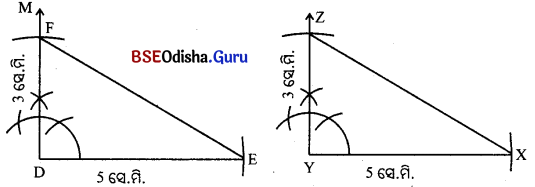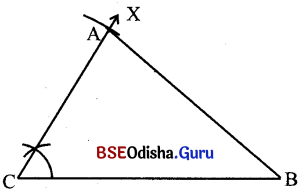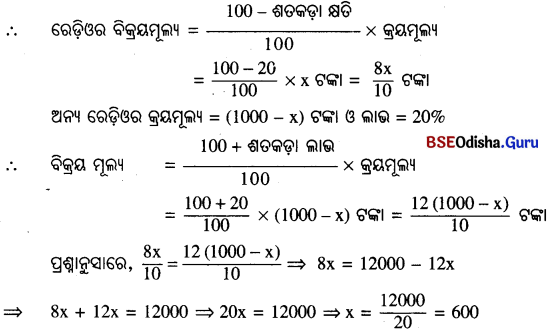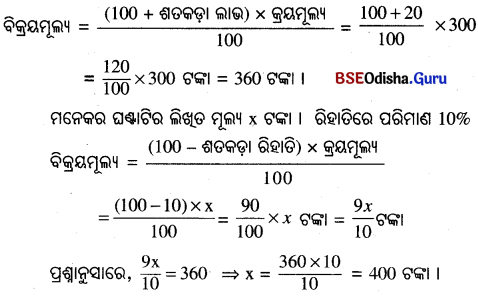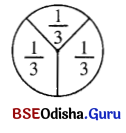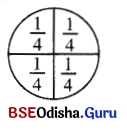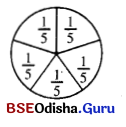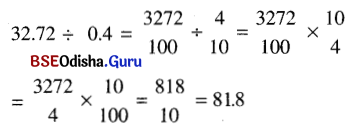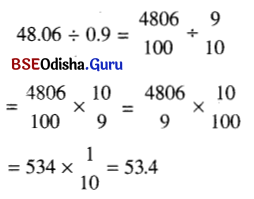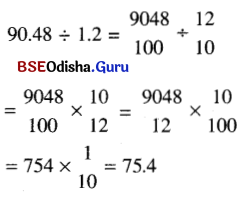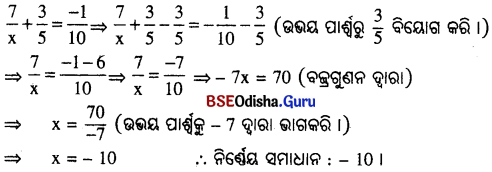Odisha State Board CHSE Odisha Class 12 History Solutions Chapter 1 ପ୍ରାଚୀନ ଭାରତ ଇତିହାସର ଉପାଦାନ Short & Long Answer Questions.
CHSE Odisha 12th Class History Chapter 1 Short & Long Answer Questions in Odia Medium
ସଂକ୍ଷିପ୍ତ ଉତ୍ତରମୂଳକ ପ୍ରଶ୍ନୋତ୍ତର
A. ଦୁଇଟି / ତିନୋଟି ବାକ୍ୟରେ ଉତ୍ତର ଦିଅ ।
୧। ଛାପାମୁଦ୍ରା କେଉଁ ଯୁଗରେ ପ୍ରଚଳିତ ହୋଇଥିଲା ? ସେଥିରେ କାହାର ଛାପା ଦେଖିବାକୁ ମିଳେ ?
Answer:
ମୌର୍ଯ୍ୟ ଯୁଗରେ ଛାପାମୁଦ୍ରା ପ୍ରଚଳିତ ହୋଇଥିଲା । ସେଥିରେ ଜୀବଜନ୍ତୁ, ପର୍ବତ, ବୃକ୍ଷ ଆଦିର ଛାପ ଦେଖିବାକୁ ମିଳିଥାଏ ।
୨। ପାଣିନି ଓ ପତଞ୍ଜଳି ଲେଖିଥିବା ସଂସ୍କୃତ ବ୍ୟାକରଣ ଗ୍ରନ୍ଥ ଦୁଇଟିର ନାମ ଲେଖ । ଏଥିରେ କ’ଣ ଉଲ୍ଲେଖ କରାଯାଇଛି ?
Answer:
ଖ୍ରୀଷ୍ଟପୂର୍ବ ଚତୁର୍ଥ ଶତାବ୍ଦୀରେ ପାଣିନି ‘ଅଷ୍ଟାଧ୍ୟାୟୀ’ ଏବଂ ଖ୍ରୀଷ୍ଟପୂର୍ବ ଦ୍ବିତୀୟ ଶତାବ୍ଦୀରେ ପତଞ୍ଜଳି ‘ମହାଭାଷ୍ୟ’ ରଚନା କରିଥିଲେ । ଏହି ଗ୍ରନ୍ଥଦ୍ଵୟରେ ସେ ଯୁଗର ରାଜ୍ୟଶାସନ ଉପରେ ଆଲୋକପାତ କରାଯାଇଛି ।
୩ । ‘ମାଳାବିକାଗ୍ନିମିତ୍ରମ୍’ର ଲେଖକ କିଏ ? କେଉଁ ଶୃଙ୍ଗ ରାଜାଙ୍କ ଉପରେ ସେହି ଗ୍ରନ୍ଥରେ ବର୍ଣ୍ଣନା କରାଯାଇଛି ?
Answer:
‘ମାଳାବିକାଗ୍ନିମିତ୍ରମ୍’ର ଲେଖକ କବି ଓ ନାଟ୍ୟକାର କାଳିଦାସ ଅଟନ୍ତି । ଶୃଙ୍ଗରାଜା ପୁଷ୍ୟାମିତ୍ର ଶୃଙ୍ଗଙ୍କ ଉପରେ ସେ ଗ୍ରନ୍ଥରେ ବର୍ଣ୍ଣନା କରାଯାଇଛି ।
୪। ମହାଭାରତର ରଚୟିତା କିଏ ? ଏହା କେତେ ଭାଗରେ ବିଭକ୍ତ ?
Answer:
ମହାଭାରତର ରଚୟିତା ବ୍ୟାସଦେବ । ଏହା ୧୮ଟି ଭାଗରେ ବିଭକ୍ତ ।

୫ । ଅଶୋକ କେଉଁ ଚାରୋଟି ଲିପି ବ୍ୟବହାର କରିଥିଲେ ଓ ସେଗୁଡ଼ିକ କ’ଣ କ’ଣ ?
Answer:
ଅଶୋକ ଚାରିଗୋଟି ଲିପି ବ୍ୟବହାର କରିଥିଲେ । ସେଗୁଡ଼ିକ ହେଲା – ଆଫଗାନିସ୍ଥାନ ଶିଳାଲେଖରେ ଆରମାଇକ୍ ଓ ଗ୍ରୀକ୍ ଲିପି ବ୍ୟବହାର ହେଉଥିଲାବେଳେ ପାକିସ୍ତାନର ଶିଳାଲେଖ ଉତ୍କର୍ଷ ହୋଇଥିଲା ଖରୋଷ୍ଟି ଲିପିରେ । ଏତଦ୍ବ୍ୟତୀତ ସାମ୍ରାଜ୍ୟର ଅନ୍ୟ ସ୍ଥାନମାନଙ୍କରେ ବ୍ରାହ୍ମୀଲିପିର ବ୍ୟବହାର ହେଉଥିଲା ।
୬ । ମେହରୌଲୀ ଲୌହସ୍ତମ୍ଭ ଏବଂ ଆଲ୍ଲାହାବାଦ ସ୍ତମ୍ଭଲେଖରେ କ’ଣ ଉଲ୍ଲେଖ ଅଛି ? କେଉଁ ସ୍ତମ୍ଭଲେଖ ନ ଥିଲେ ବିଖ୍ୟାତ ସମ୍ରାଟ ସମୁଦ୍ରଗୁପ୍ତ ଭାରତ ଇତିହାସରେ ଅଜଣା ହୋଇ ରହିଥା’ନ୍ତେ ?
Answer:
ଲୌହସ୍ତମ୍ଭରେ ରାଜା ବିକ୍ରମାଦିତ୍ୟ ବଙ୍ଗ ଶାସକଙ୍କୁ ପରାସ୍ତ କରିବା ବିଷୟ ଉଲ୍ଲେଖ ଅଛି । ଆଲ୍ଲାହାବାଦ ସ୍ତମ୍ଭଲେଖ ନ ଥିଲେ ବିଖ୍ୟାତ ସମ୍ରାଟ ସମୁଦ୍ରଗୁପ୍ତ ଭାରତ ଇତିହାସରେ ଅଜଣା ହୋଇ ରହିଥା’ନ୍ତେ ।
୭। କିଏ, କେବେ ଅଶୋକଙ୍କ ଅଭିଲେଖର ଅକ୍ଷରଗୁଡ଼ିକ ପାଠ କରିବାରେ ସଫଳତା ଲାଭ କରିଥିଲେ ?
Answer:
ପାଶ୍ଚାତ୍ୟ ବିଦ୍ବାନ୍ ଜେମ୍ସ ପ୍ରିନ୍ସେପ୍ ଅଶୋକଙ୍କର ଅଭିଲେଖର ଅକ୍ଷରଗୁଡ଼ିକ ପାଠ କରିବାରେ ସଫଳତା ହାସଲ କରିଥିଲେ । ସେ ୧୮୧୭ ମସିହାରେ ଏହାକୁ ପାଠ କରିବାରେ ସଫଳ ହୋଇଥିଲେ ।
୮। ଅଭିଲେଖଗୁଡ଼ିକ କେତେ ପ୍ରକାରର ଓ କ’ଣ କ’ଣ ? ପ୍ରଶଂସାବ୍ୟଞ୍ଜକ ଅଭିଲେଖରେ କେଉଁମାନଙ୍କର ଗୁଣ କୀର୍ତ୍ତନ କରାଯାଇଥାଏ ?
Answer:
ଅଭିଲେଖଗୁଡ଼ିକ ବିଭିନ୍ନ ପ୍ରକାରର ଥିଲା, ଯଥା – ପ୍ରଶଂସାବ୍ୟଞ୍ଜକ ଅଭିଲେଖ, ସ୍ମାରକ ଅଭିଲେଖ, ଧର୍ମୀୟ ଅଭିଲେଖ, ଆଜ୍ଞାପତ୍ର ଓ ଦାନପତ୍ର । ପ୍ରଶଂସାବ୍ୟଞ୍ଜକ ଅଭିଲେଖରେ ରାଜାମାନଙ୍କର ଗୁଣ କୀର୍ତ୍ତନ କରାଯାଇଥାଏ ।
୯। ହର୍ଷଙ୍କ ଶାସନ କାଳରେ କେଉଁ ପରିବ୍ରାଜକ ଭାରତ ମାଟିରେ ପଦାର୍ପଣ କରିଥିଲେ, ସେ କେବେ ଓ କେଉଁ ବୌଦ୍ଧପୀଠଗୁଡ଼ିକୁ ଭ୍ରମଣ କରିଥିଲେ ? ତାଙ୍କଦ୍ୱାରା ରଚିତ ଗ୍ରନ୍ଥର ନାମ କ’ଣ ?
Answer:
ହର୍ଷଙ୍କ ଶାସନ କାଳରେ ଚୀନ୍ ପରିବ୍ରାଜକ ହୁଏନ୍ସାଂ ଭାରତ ମାଟିରେ ପଦାର୍ପଣ କରିଥିଲେ । ସେ ୬୩୦ ରୁ ୬୪୪ ଖ୍ରୀ.ଅ. ପର୍ଯ୍ୟନ୍ତ ଥାନେଶ୍ବର, ଅଯୋଧ୍ୟା, ପ୍ରୟାଗ, କନୌଜ, ମହାରାଷ୍ଟ୍ର, କର୍ଣ୍ଣସୁବର୍ଣ୍ଣ, କାମରୂପ, ଶ୍ରାବସ୍ତୀ, ପୁଣ୍ଡବର୍ଦ୍ଧନ ଆଦି ସ୍ଥାନରେ ଥିବା ବୌଦ୍ଧପୀଠଗୁଡ଼ିକୁ ଭ୍ରମଣ କରିଥିଲେ । ସେ ତାଙ୍କର ଭ୍ରମଣ ବୃତ୍ତାନ୍ତକୁ ‘ସି-ୟୁ-କି’ ନାମକ ଗ୍ରନ୍ଥରେ ସ୍ଥାନ ଦେଇଥିଲେ ।
୧୦ । ଇତ୍ସିଂ କେବେ ଭାରତ ଭ୍ରମଣରେ ଆସି କେଉଁ ଧର୍ମ ବିଷୟରେ ଅନୁଧ୍ୟାନ କରିଥିଲେ ? ସେ କ’ଣ ଲେଖିଛନ୍ତି ?
Answer:
ସପ୍ତମ ଶତାବ୍ଦୀରେ ଇତ୍ସିଂ ଭାରତ ଭ୍ରମଣରେ ଆସି ବୌଦ୍ଧଧର୍ମ ବିଷୟରେ ଅନୁଧ୍ୟାନ କରିଥିଲେ । ସେ ସେତେବେଳେ ଭାରତରେ ବୌଦ୍ଧଧର୍ମ କିପରି ପତନ ଆଡ଼କୁ ଗତି କରୁଥିଲା ଲେଖିବା ସହିତ ଭାରତର ସାମାଜିକ ଓ ଆର୍ଥନୀତିକ ଅବସ୍ଥା ବର୍ଣ୍ଣନା କରିଥିଲେ ।

୧୧ । ଫାହିୟାନ୍ କେଉଁ ଶତାବ୍ଦୀରେ ଭାରତ ଆସି ସେଠାରେ କେତେ ବର୍ଷ କାଳ ଅବସ୍ଥାନ କରିଥିଲେ ? ତାଙ୍କ ପୁସ୍ତକର ନାମ କ’ଣ ?
Answer:
ପଞ୍ଚମ ଶତାବ୍ଦୀରେ ଫାହିୟାନ୍ ଭାରତ ଆସି ସେଠାରେ ୧୫ ବର୍ଷକାଳ ଅବସ୍ଥାନ କରିଥିଲେ । ତାଙ୍କ ପୁସ୍ତକର ନାମ ‘ଫୋ-କିଓ-କି’ ଥିଲା ।
୧୨ । ଜିଆଉଦ୍ଦିନ୍ ବରାନୀଙ୍କ ପୁସ୍ତକର ନାମ କ’ଣ ? ସେଥୁରେ କେଉଁ ସମୟର ଭାରତର ଇତିହାସ ଲିପିବଦ୍ଧ ହୋଇଛି ?
Answer:
ଜିଆଉଦ୍ଦିନ୍ ବରାନୀଙ୍କର ପୁସ୍ତକର ନାମ ‘ତାରିଖ-ଇ-ଫିରୋଜଶାହୀ’ ଅଟେ । ସେଥିରେ ୧୨୫୯ ରୁ ୧୩୫୩ ଖ୍ରୀ.ଅ. ପର୍ଯ୍ୟନ୍ତ ଭାରତର ଇତିହାସ ଲିପିବଦ୍ଧ ରହିଛି ।
୧୩ । ଗୋଆଲିୟର ପ୍ରଶସ୍ତି ଏବଂ ଐହୋଲ ପ୍ରଶସ୍ତିରେ କାହା ସମ୍ପର୍କରେ ଉଲ୍ଲେଖ କରାଯାଇଛି ? ଖାରବେଳଙ୍କ ରାଜତ୍ଵ ସମ୍ବନ୍ଧରେ କେଉଁ ଅଭିଲେଖରେ ବର୍ଣ୍ଣନା କରାଯାଇଛି ?
Answer:
ଗୋଆଲିୟର ପ୍ରଶସ୍ତିରେ ପ୍ରତିହାର ଶାସକ ଭୋଜରାଜଙ୍କର ସୁଶାସନ ସମ୍ପର୍କରେ ଉଲ୍ଲେଖ କରାଯାଇଥିଲାବେଳେ ଐହୋଲ ପ୍ରଶସ୍ତିରୁ ହର୍ଷ ଚାଲୁକ୍ୟ ରାଜ୍ୟ ଦ୍ବିତୀୟ ପୁଲକେଶୀଙ୍କଦ୍ଵାରା କିପରି ପରାଜିତ ହୋଇଥିଲେ ସେହି ବିଷୟରେ ଉଲ୍ଲେଖ କରାଯାଇଛି । ଖାରବେଳଙ୍କ ରାଜତ୍ଵ ସମ୍ବନ୍ଧରେ ହାତୀଗୁମ୍ଫା ଅଭିଲେଖରେ ବର୍ଣ୍ଣନା କରାଯାଇଛି ।
୧୪ । ବୋଘାଜକୋଇ ଶିଳାଲେଖ କେଉଁଠାରୁ ଆବିଷ୍କାର କରାଯାଇଛି ? ସେଥିରେ ଆର୍ଯ୍ୟମାନଙ୍କର କେଉଁ ଦେବତାମାନଙ୍କ କଥା ଉଲ୍ଲେଖ କରାଯାଇଛି ?
Answer:
ବୋଘାଜକୋଇ ଶିଳାଲେଖ ଏସିଆ ମାଇନର ଅଞ୍ଚଳରୁ ଆବିଷ୍କାର କରାଯାଇଛି । ସେଥରେ ଆର୍ଯ୍ୟମାନଙ୍କର ଇନ୍ଦ୍ର, ବରୁଣ, ମିତ୍ର ଆଦି ଦେବତାମାନଙ୍କର କଥା ଉଲ୍ଲେଖ କରାଯାଇଛି ।
୧୫ । କେଉଁଠାରେ ଜୈନ ଗୁମ୍ଫାମାନ ଦେଖିବାକୁ ମିଳେ ?
Answer:
କର୍ଣ୍ଣାଟକର ଗୋମତେଶ୍ଵର ବାହୁବଳୀ ମୂର୍ତ୍ତି, ଭୁବନେଶ୍ବରରେ ଖଣ୍ଡଗିରି-ଉଦୟଗିରି, ମଧ୍ୟପ୍ରଦେଶର ଏଲୋରା ଏବଂ ମହାରାଷ୍ଟ୍ରରେ ଜୈନଗୁମ୍ଫାମାନ ଦେଖିବାକୁ ମିଳେ ।
୧୬ । କେଉଁଠାରେ ଜୈନ କୀର୍ତ୍ତିମାନ ଦେଖିବାକୁ ମିଳିଥାଏ ?
Answer:
ବିହାରର ପାର୍ଶ୍ଵନାଥ ମନ୍ଦିର, ପାବାପୁରୀ ଏବଂ ରାଜଗିରି, କାଥୁଆୱାଡ଼ର ଗିରନାର୍ ଏବଂ ପାଲିତନ ଏବଂ ରାଜସ୍ଥାନର ଆବୁ ପର୍ବତସ୍ଥିତ ଦିଲୱାରା ଇତ୍ୟାଦି ସ୍ଥାନରେ ଜୈନ କୀର୍ତ୍ତିମାନ ଦେଖିବାକୁ ମିଳେ ।

୧୭ । ପ୍ରାଚୀନ ଭାରତରେ କେତେଖଣ୍ଡ ପୁରାଣ ରଚିତ ହୋଇଥିଲା ? କେତୋଟି ପ୍ରସିଦ୍ଧ ପୁରାଣର ନାମ ଲେଖ । ପୁରାଣର ମୁଖ୍ୟ ଲକ୍ଷଣ କ’ଣ ?
Answer:
ପ୍ରାଚୀନ ଭାରତରେ ଅଷ୍ଟାଦଶ ପୁରାଣ ଅର୍ଥାତ୍ ୧୮ ଖଣ୍ଡ ପୁରାଣ ରଚିତ ହୋଇଥିଲା । କେତୋଟି ପ୍ରସିଦ୍ଧ ପୁରାଣର ନାମ ହେଲା – ବାୟୁପୁରାଣ, ବିଷ୍ଣୁପୁରାଣ, ମତ୍ସ୍ୟ ପୁରାଣ, ବ୍ରହ୍ମାଣ୍ଡ ପୁରାଣ, ଅଗ୍ନି ପୁରାଣ ଇତ୍ୟାଦି । ପୁରାଣର ବଂଶାବଳୀ ବର୍ଣ୍ଣନା ପୁରାଣର ଏକ ମୁଖ୍ୟ ଲକ୍ଷଣ ।
୧୮ । ‘ଅର୍ଥଶାସ୍ତ୍ର’ କେତୋଟି ଅଧ୍ୟାୟରେ ବିଭକ୍ତ ହୋଇଛି ? ଏହା କେଉଁ ଯୁଗରେ ରଚିତ ହୋଇଥିଲା ? ଉକ୍ତ ଗ୍ରନ୍ଥରେ କେଉଁ ବିଷୟରେ ଆଲୋଚନା କରାଯାଇଛି ?
Answer:
କୌଟିଲ୍ୟଙ୍କ ‘ଅର୍ଥଶାସ୍ତ୍ର’ ୧୫ଟି ଅଧ୍ୟାୟରେ ବିଭକ୍ତ । ଏହା ମୌର୍ଯ୍ୟ ଯୁଗରେ ରଚିତ ହୋଇଥିଲା । ଉକ୍ତ ଶାସ୍ତ୍ରରେ ରାଜ୍ୟ ଶାସନ, ଅର୍ଥନୀତି, ଦଣ୍ଡନୀତି, ସମାଜ ଓ ବୈଦେଶିକ ସମ୍ପର୍କ ଉପରେ ବିଶେଷ ଭାବରେ ଆଲୋଚନା କରାଯାଇଛି ।
୧୯ । ମେଘାସ୍ଥିନିସ୍ କିଏ ? ତାଙ୍କ ରଚିତ ପୁସ୍ତକର ନାମ କ’ଣ ? ଭାରତର କେଉଁଠାରେ ସେ ଅବସ୍ଥାନ କରିଥିଲେ ?
Answer:
ଗ୍ରୀକ୍ ରାଷ୍ଟ୍ରଦୂତ ମେଘାସ୍ଥିନିସ୍ ଗ୍ରୀକ୍ ସେନାପତି ସେଲିଉକ୍ସଙ୍କଦ୍ୱାରା ଚନ୍ଦ୍ରଗୁପ୍ତ ମୌର୍ଯ୍ୟଙ୍କ ରାଜଦରବାରକୁ ପ୍ରେରିତ ହୋଇଥିଲେ । ତାଙ୍କଦ୍ୱାରା ରଚିତ ପୁସ୍ତକର ନାମ ‘ଇଣ୍ଡିକା’ ଥିଲା । ସେ ପାଟଳୀପୁତ୍ର ନଗରୀରେ ଅବସ୍ଥାନ କରିଥିଲେ ।
୨୦ । ଆଲ୍ବେରୁଣୀ କିଏ ? ତାଙ୍କ ରଚିତ ପୁସ୍ତକର ନାମ କ’ଣ ?
Answer:
ଅଷ୍ଟମ ଶତାବ୍ଦୀର ପ୍ରସିଦ୍ଧ ଆରବୀୟ ଲେଖକ ଥିଲେ ଆଲ୍ବେରୁଣୀ । ତାଙ୍କ ରଚିତ ପୁସ୍ତକର ନାମ ଥିଲା ‘ତାହିକ୍- ଇ-ହିନ୍ଦ୍’ ।
୨୧ । ପ୍ରାଚୀନ ଭାରତର ଇତିହାସ ରଚନା କରିବାପାଇଁ କେଉଁ କେଉଁ ଉପାଦାନ ଉପରେ ନିର୍ଭର କରିବାକୁ ପଡ଼ିଥାଏ ? ଆଧୁନିକ ଯୁଗର ଇତିହାସ ରଚନା କରିବାପାଇଁ କେଉଁ ଉପାଦାନର ଆବଶ୍ୟକତା ରହିଛି ?
Answer:
ପ୍ରାଚୀନ ଭାରତର ଇତିହାସ ରଚନା କରିବାପାଇଁ ସାହିତ୍ୟକୃତି, ଅଭିଲେଖ, ବୈଦେଶିକ ବିବରଣୀ, ମୁଦ୍ରା, ମାଟିପାତ୍ର, ଧାତବ ଉପକରଣ ଏବଂ ଅନ୍ୟାନ୍ୟ ପ୍ରତ୍ନତାତ୍ତ୍ଵିକ ଭଗ୍ନାବଶେଷ ଉପରେ ନିର୍ଭର କରିବାକୁ ପଡ଼ିଥାଏ । ଆଧୁନିକ ଯୁଗର ଇତିହାସ ରଚନା କରିବାପାଇଁ ଅଭିଲେଖାଗାରୀୟ ଉପାଦାନର ଆବଶ୍ୟକତା ରହିଛି ।

୨୨ । ବେଦ କେତେ ଭାଗରେ ବିଭକ୍ତ ? ପ୍ରାଚୀନ ଭାରତ ଇତିହାସ ରଚନା ଦିଗରେ ଏହା କିପରି ସହାୟକ ହୋଇଥାଏ ?
Answer:
ବେଦ ଚାରିଭାଗରେ ବିଭକ୍ତ; ଯଥା – ରକ୍, ସାମ୍, ଯଜୁ, ଅଥର୍ବ । ବେଦରୁ ଆର୍ଯ୍ୟମାନଙ୍କର ଗତି, ବସତି, ରାଜ୍ୟ ଶାସନ, ସଭା-ସମିତି, ଶିକ୍ଷା, ପ୍ରକୃତି ଉପାସନା ଆଦି ସମ୍ପର୍କରେ ଜାଣିବାକୁ ମିଳିଥାଏ ।
୨୩ । ପ୍ରଶଂସାବ୍ୟଞ୍ଜକ ଅଭିଲେଖ କ’ଣ ? ଏହାର ଦୁଇଟି ଉଦାହରଣ ପ୍ରଦାନ କର ।
Answer:
ପ୍ରଶଂସାବ୍ୟଞ୍ଜକ ଅଭିଲେଖ ମାଧ୍ୟମରେ ଶାସକମାନେ ନିଜ ନିଜର ପ୍ରଶଂସା ବ୍ୟକ୍ତ କରୁଥିଲେ । ଗୁପ୍ତ ସମ୍ରାଟ ସମୁଦ୍ରଗୁପ୍ତଙ୍କ ଉଦ୍ଦିଷ୍ଟ ହରିଶେଣଙ୍କଦ୍ଵାରା ରଚିତ ପ୍ରୟାଗ ପ୍ରଶସ୍ତି, ସାତବାହନ ଶାସକ ଗୌତମୀପୁତ୍ର ସାତକର୍ଣ୍ଣୀଙ୍କ ଗୁଣଗାନ କରୁଥୁବା ନାସିକ ପ୍ରଶସ୍ତି, ଚାଲୁକ୍ୟ ବଂଶର ଦ୍ଵିତୀୟ ପୁଲକେଶୀଙ୍କ ନାମ ବର୍ଣନା କରୁଥିବା ଐହୋଲ ପ୍ରଶସ୍ତି ଆଦି ପ୍ରଶଂସାବ୍ୟଞ୍ଜକ ଅଭିଲେଖର୍ ନମୁନା ।
୨୪ । ସ୍ମାରକ ଅଭିଲେଖରେ କେଉଁ ଘଟଣାମାନ ସ୍ଥାନ ପାଉଥିଲା ? ଏହାର ଦୁଇଟି ଉଦାହରଣ ପ୍ରଦାନ କର ।
Answer:
ସ୍ମାରକ ଅଭିଲେଖରେ ଜଣେ ଶାସକଙ୍କ ରାଜ୍ୟ ଶାସନ ସମ୍ପର୍କିତ ମହନୀୟ ଘଟଣାମାନ ସ୍ଥାନ ପାଉଥିଲା । ସମ୍ରାଟ ଅଶୋକଙ୍କ ଲୁମ୍ବିନୀ ଅଭିଲେଖ ଏବଂ ସମ୍ରାଟ ଖାରବେଳଙ୍କ ହାତୀଗୁମ୍ଫା ଅଭିଲେଖ ଏହାର ଉଦାହରଣ ଅଟେ ।
୨୫ । ଆଜ୍ଞାପତ୍ର କ’ଣ ? ଯେକୌଣସି ଦୁଇଟି ଆଜ୍ଞାପତ୍ରର ନାମ ଲେଖ ।
Answer:
ଆଜ୍ଞାପତ୍ରଗୁଡ଼ିକରେ ରାଜାଙ୍କର ଆଦେଶ ଉତ୍କର୍ଣ୍ଣ ହେଉଥିଲା । ହର୍ଷବର୍ଦ୍ଧନଙ୍କ ବଂଶଖେରା ଏବଂ ମଧୁବନ ଆଜ୍ଞାପତ୍ର, ନାଳନ୍ଦା ତାମ୍ରପତ୍ର ଏବଂ ଓଡ଼ିଶାର ଗଙ୍ଗବଂଶ ଏବଂ ସୂର୍ଯ୍ୟବଂଶ ଶାସନ ସମୟରେ ତାମ୍ରପଟ୍ଟାମାନ ଆଜ୍ଞାପତ୍ରର ଉଦାହରଣ ଅଟେ ।
୨୬ । ପ୍ରାଚୀନ ଭାରତର ଇତିହାସ ରଚନା କରିବାପାଇଁ ‘ରାମାୟଣ’ କିପରି ସହାୟକ ହୋଇଥାଏ ? ଏହା କେତେ ଖଣ୍ଡରେ ବିଭକ୍ତ ?
Answer:
‘ରାମାୟଣ’ରେ ରାମଙ୍କର ବନବାସ ଏବଂ ଯୁଦ୍ଧ ବର୍ଣ୍ଣନାରୁ ସେତେବେଳର ଆର୍ଯ୍ୟ ଏବଂ ଦ୍ରାବିଡ଼ମାନଙ୍କ ମଧ୍ୟରେ ସଂଘର୍ଷ, ଅଶ୍ଵମେଧ ଯଜ୍ଞ, ଦକ୍ଷିଣଆଡ଼କୁ ଆର୍ଯ୍ୟମାନଙ୍କର ଗତି ଏବଂ ସାମାଜିକ କର୍ତ୍ତବ୍ୟବୋଧ ଆଦି ବିଷୟରେ ଜାଣିବାକୁ ମିଳିଥାଏ । ଏହି ମହାକାବ୍ୟ ସାତଖଣ୍ଡରେ ବିଭକ୍ତ ଅଟେ ।
୨୭ । ଐତିହାସିକ ଉପାଦାନ ଭାବେ ଫାହିୟାଙ୍କ ବିବରଣୀର ବିଶେଷତ୍ଵ କ’ଣ ? ସେ କେଉଁ ସମ୍ରାଟଙ୍କ ରାଜତ୍ଵ ସମୟରେ ଭାରତ ଆସିଥିଲେ ?
Answer:
ଚୀନ୍ ପରିବ୍ରାଜକ ଫାହିୟାନ୍ଙ୍କ ଲିଖ୍ ଭାରତ ସମ୍ବନ୍ଧୀୟ ବିବରଣୀ ‘ଫୋ-କିଓ-କି’ରୁ ତତ୍କାଳୀନ ସମାଜର ରାଜନୈତିକ, ସାମାଜିକ, ଅର୍ଥନୈତିକ ଏବଂ ଧର୍ମୀୟ ଅବସ୍ଥା ସମ୍ବନ୍ଧରେ ଜାଣିବାକୁ ମିଳିଥାଏ । ଫାହିୟାନ୍ ଗୁପ୍ତ ସମ୍ରାଟ ଦ୍ବିତୀୟ ଚନ୍ଦ୍ରଗୁପ୍ତଙ୍କ ରାଜତ୍ଵ ସମୟରେ ଭାରତ ଆସିଥୁଲେ ।

B. ପାଞ୍ଚଟି / ଛଅଟି ବାକ୍ୟରେ ଉତ୍ତର ଦିଅ ।
୧। କେଉଁ କେଉଁ ଉପାଦାନଗୁଡ଼ିକ ପ୍ରାଚୀନ ଭାରତ ଇତିହାସ ରଚନା ପାଇଁ ସହାୟକ ହୋଇଥାଏ ?
Answer:
ଯେକୌଣସି ଇତିହାସ ରଚନା କରିବାପାଇଁ ମୌଳିକ ଉପାଦାନଗୁଡ଼ିକର ଆବଶ୍ୟକତା ପଡ଼େ । ସେହିପରି ପ୍ରାଚୀନ ଭାରତ ଇତିହାସ ରଚନାପାଇଁ ଆମେ ମୁଖ୍ୟତଃ ତିନିପ୍ରକାର ଉପାଦାନ ଉପରେ ନିର୍ଭର କରିଥାଉ । ସେଗୁଡ଼ିକ ହେଲା – ପ୍ରନୃତାତ୍ତ୍ଵିକ ଉପାଦାନ, ସାହିତ୍ୟିକ ଉପାଦାନ ଏବଂ ଅଭିଲେଖାଗାରୀୟ ଉପାଦାନ । ପ୍ରସୂତାତ୍ତ୍ଵିକ ଉପାଦାନକୁ ତିନିଭାଗରେ ବିଭକ୍ତ କରାଯାଇଛି; ଯଥା— ଖୋଦିତ ଲେଖ ବା ଲିପି, ପ୍ରନତାତ୍ତ୍ୱିକ ଧ୍ୱଂସାବଶେଷ ଓ ସ୍ଥାପତ୍ୟରାଜି ଏବଂ ମୁଦ୍ରା । ସେହିପରି ସାହିତ୍ୟିକ ଉପାଦାନକୁ ମଧ୍ଯ ତିନିଭାଗରେ ବିଭକ୍ତ କରାଯାଇଛି; ଯଥା— ଧର୍ମୀୟ ସାହିତ୍ୟ, ଲୌକିକ ସାହିତ୍ୟ ଏବଂ ବୈଦେଶିକ ବିବରଣୀ । ଅଭିଲେଖାଗାରୀୟ ଉପାଦାନ ହେଉଛି – ସରକାରୀ ଚିଠି, ବ୍ୟକ୍ତିଗତ କାଗଜପତ୍ର, ଦଲିଲ ଓ ଦସ୍ତାବିଜ୍, ଖବରକାଗଜ ଓ ପତ୍ରପତ୍ରିକା, ପତ୍ରବିନିମୟ ଆଦି ।
୨ । ପ୍ରାଚୀନ ଭାରତ ଇତିହାସ ରଚନା ପାଇଁ ଲୋକସାହିତ୍ୟର ଆବଶ୍ୟକତା କ’ଣ ?
Answer:
ଲୋକସାହିତ୍ୟ ବା ଲୌକିକ ସାହିତ୍ୟରୁ ପ୍ରାଚୀନ ଭାରତର ବର୍ଷବ୍ୟବସ୍ଥା, ଦଣ୍ଡବ୍ୟବସ୍ଥା, ନୀତି, ଆଦର୍ଶ, ବୈଦେଶିକ ନୀତି ଓ ଅର୍ଥନୀତି ପ୍ରଭୃତି ବିଷୟର ପୂର୍ଣ୍ଣ ବିବରଣୀ ମିଳେ । ମନୁ ସ୍ମୃତି, ଯାଜ୍ଞବଳ୍କ୍ୟ ସ୍ମୃତି ଓ ପରାଶର ସ୍ମୃତିରୁ ପ୍ରାଚୀନ ଭାରତରେ ସାମାଜିକ, ରାଜନୀତି ଓ ଧର୍ମ ସମ୍ବନ୍ଧୀୟ ଜୀବନର ଚିତ୍ର ମିଳିଥାଏ । ବିଶାଖାଦତ୍ତଙ୍କ ମୁଦ୍ରାରାକ୍ଷସରୁ ମୌର୍ଯ୍ୟଯୁଗର ଇତିହାସ ଓ ଦେବୀଚନ୍ଦ୍ରଗୁପ୍ତମ୍ ଗ୍ରନ୍ଥରୁ ଦ୍ୱିତୀୟ ଚନ୍ଦ୍ରଗୁପ୍ତଙ୍କ ଶାସନ ବିଷୟରେ ବିଶଦ ବିବରଣୀ ମିଳିଥାଏ । ପାଣିନିଙ୍କ ଅଷ୍ଟାଧ୍ୟାୟୀ ଓ ପତଞ୍ଜଳିଙ୍କ ମହାଭାଷ୍ୟ ସଂସ୍କୃତ ବ୍ୟାକରଣରୁ ତତ୍କାଳୀନ ଗଣତନ୍ତ୍ର ଶାସନ ବିଷୟରେ ସୂଚନା ମିଳେ । କାଳଜୟୀ ନାଟ୍ୟକାର କାଳିଦାସଙ୍କ ସାହିତ୍ୟକୃତି; ଯଥା- ମାଳବିକାଗ୍ନିମିତ୍ରମ୍, ଅଭିଜ୍ଞାନଶାକୁନ୍ତଳମ୍, ବିକ୍ରମୋର୍ବଶୀୟମ୍, ମେଘଦୂତ, ରଘୁବଂଶ ପ୍ରଭୃତି ନାଟକ ଓ ଗ୍ରନ୍ଥ ଇତିହାସ ରଚନା ପାଇଁ ସହାୟକ ହୋଇଥା’ନ୍ତି । ଓଡ଼ିଶା ଇତିହାସ ରଚନା ପାଇଁ ମାଦଳାପାଞ୍ଜି ଓ କଟକ ରାଜବଂଶାବଳୀ ବହୁ ଉପାଦେୟ ତଥ୍ୟ ପ୍ରଦାନ କରିଥାଏ ।

୩ । ହୁଏନ୍ସାଂଙ୍କ ସମ୍ବନ୍ଧରେ ଏକ ବିବରଣୀ ପ୍ରଦାନ କର ।
Answer:
ପ୍ରାଚୀନ ଭାରତର ବୈଦେଶିକ ଭ୍ରମଣକାରୀଙ୍କ ମଧ୍ୟରେ ହୁଏନ୍ସାଂ ଅତି ପ୍ରସିଦ୍ଧ । ହର୍ଷବର୍ଦ୍ଧନଙ୍କ ରାଜତ୍ଵ ସମୟରେ ସେ ଭାରତ ପରିଭ୍ରମଣରେ ଆସିଥିଲେ । ସେ ଖ୍ରୀ.ଅ. ୬୩୦ରୁ ୬୪୪ ପର୍ଯ୍ୟନ୍ତ ଦୀର୍ଘ ଚଉଦବର୍ଷକାଳ ଭାରତର କନୌଜ, ଥାନେଶ୍ଵର, କଙ୍ଗୋଦ, ନେପାଳ ଓ ନାଳନ୍ଦା ପ୍ରଭୃତି ବିଭିନ୍ନ ସ୍ଥାନ ଭ୍ରମଣ କରିଥିଲେ । ସେ ‘ସି-ୟୁ-କି’ ନାମକ ଗ୍ରନ୍ଥ ରଚନା କରିଥିଲେ । ହର୍ଷଙ୍କର ରାଜ୍ୟଜୟ, ଶାସନନୀତି ଓ ଧର୍ମ ବିଷୟରେ ସେ ବହୁ ଉପାଦେୟ ବିବରଣୀ ପ୍ରଦାନ କରିଥିଲେ । ସେ ପ୍ରୟାଗ ଓ କନୌଜ ଧର୍ମସଭା କଥା ଉଲ୍ଲେଖ କରିଛନ୍ତି । ହୁଏନ୍ସାଂ ନାଳନ୍ଦା ବିଶ୍ଵବିଦ୍ୟାଳୟରେ ଦଶହଜାର ଛାତ୍ର ଅଧ୍ୟୟନ କରୁଥିବାର ବର୍ଣ୍ଣନା କରିଛନ୍ତି । ହୁଏନ୍ସାଂ ଓଡ଼ିଶାର ପୁଷ୍ପଗିରି ନାମକ ବିଶ୍ଵବିଦ୍ୟାଳୟ ଦେଖୁବାକୁ ଯାଇଥିଲେ । ହର୍ଷଯୁଗର ଇତିହାସ ପାଇଁ ହୁଏନ୍ସାଂଙ୍କ ଭ୍ରମଣ ବୃତ୍ତାନ୍ତ ଏକ ମହାର୍ଘ ଐତିହାସିକ ଉପାଦାନ ଅଟେ ।
୪। ଅଭିଲେଖାଗାରୀୟ ଉପାଦାନ ଭାବେ ଖବରକାଗଜ ଓ ପତ୍ରପତ୍ରିକାଗୁଡ଼ିକର ଭୂମିକା ସମ୍ପର୍କରେ ଲେଖ ।
Answer:
ଅଭିଲେଖାଗାରୀୟ ଉପାଦାନ ଭାବେ ଖବରକାଗଜ ଓ ପତ୍ରପତ୍ରିକାଗୁଡ଼ିକର ଭୂମିକା ଅତୀବ ଗୁରୁତ୍ଵପୂର୍ଣ । ଏଥିରେ ବିଭିନ୍ନ ସମୟରେ ଘଟିଥିବା ଘଟଣାବଳୀର ପରିପ୍ରକାଶ ଘଟିଥାଏ । ଏହି ଘଟଣାବଳୀକୁ ପରୀକ୍ଷା ନିରୀକ୍ଷା କରି ଏବଂ ଏଥୁରୁ ଉପାଦାନ ସଂଗ୍ରହ କରି ଇତିହାସ ରଚନା କରାଯାଇଥାଏ । ସ୍ଵାଧୀନତା ପୂର୍ବରୁ ‘ଅମୃତବଜାର ପ୍ରତିକା’, ‘ଇଂଲିସ୍ମ୍ୟାନ୍’, ‘ଯୁଗାନ୍ତର’, ‘ହିନ୍ଦୁ ପାଟ୍ରିୟ’, ‘ଦି ପାଓନିୟର’, ‘ଦି ଟାଇମ୍ସ’ ଆଦି ଖବରକାଗଜ ପ୍ରକାଶିତ ହୋଇଥିଲା । ଅଧୁନା ବହୁ ଖବରକାଗଜ ପ୍ରକାଶିତ ହେଲାଣି । ପତ୍ରିକା ମଧ୍ୟରେ ଇଂରେଜ ଶାସନ ସମୟରେ ‘ଏସିଆଟିକ୍ କ୍ୱାଟର୍ଲି ରିଭ୍ୟୁ’, ‘ସେଣ୍ଟ୍ରାଲ୍ ଏସିଆନ୍ ରିଭ୍ୟୁ’, ‘ଜର୍ଣ୍ଣାଲ୍ ଅଫ୍ ଦି ରୟାଲ ଏସିଆଟିକ୍ ସୋସାଇଟି’, ‘ଅଖବାର-ଇ-ଆସ’, ‘ହମଦର୍ଦ-ଇ-ହିନ୍ଦ’, ‘ବନାରସ୍ ଅଖବାର’, ‘ନିଆଁଖୁଣ୍ଟା’ ଆଦି ପ୍ରକାଶିତ ହେଉଥିଲା ।
୫ । ଇତିହାସ ରଚନାରେ ପୁରାଣର ଭୂମିକା ନିରୁପଣ କର ।
Answer:
ଭାରତରେ ବିଭିନ୍ନ ପ୍ରକାରର ପୁରାଣ ରହିଛି । ମୁଖ୍ୟ ପୁରାଣଗୁଡ଼ିକ ମଧ୍ୟରୁ ବିଷ୍ଣୁ ପୁରାଣ, ବାୟୁ ପୁରାଣ, ମତ୍ସ୍ୟ ପୁରାଣ, ମାର୍କଣ୍ଡେୟ ପୁରାଣ, ଅଗ୍ନି ପୁରାଣ, ବ୍ରହ୍ମାଣ୍ଡ ପୁରାଣ ପ୍ରଭୃତି ଶ୍ରେଷ୍ଠ ସ୍ଥାନ ଅଧିକାର କରିଛନ୍ତି । ପୁରାଣଗୁଡ଼ିକରେ ତତ୍କାଳୀନ ଶାସକମାନଙ୍କର ବଂଶାବଳୀ ସହିତ ସେମାନଙ୍କର କୃତିତ୍ଵ ମଧ୍ଯ ଲିପିବଦ୍ଧ ହୋଇଛି । ଗୁପ୍ତଯୁଗରେ ଅଷ୍ଟାଦଶ ପୁରାଣ ଲେଖାର ପରିସମାପ୍ତି ଘଟିଥିଲା । ପୁରାଣରୁ ଆମେ ମୌର୍ଯ୍ୟ, ଶିଶୁନାଗ, ଶୃଙ୍ଗ, ସାତବାହନ, ଗୁପ୍ତ ଆଦି ରାଜବଂଶ ବିଷୟରେ ଜାଣିବାକୁ ଯାଇଥାଉ । ପୁରାଣଗୁଡ଼ିକରୁ ମଧ୍ଯ ଐତିହାସିକ, ଭୌଗୋଳିକ ଓ ଧର୍ମବ୍ୟବସ୍ଥା ସମ୍ପର୍କରେ ଜ୍ଞାନ ଆହରଣ କରାଯାଇଥାଏ । ପୁରାଣରେ ଭାରତରେ ଥିବା ବିଭିନ୍ନ ତୀର୍ଥସ୍ଥାନ ଓ ସେଗୁଡ଼ିକର ମାହାତ୍ମ୍ୟ ବିଷୟରେ ବର୍ଣ୍ଣିତ ଅଛି ।

୬ । ଇତିହାସ ରଚନାରେ ଧର୍ମ ସାହିତ୍ୟ କିପରି ସହାୟକ ହୋଇଥାଏ ?
Answer:
ଭାରତୀୟ ଧର୍ମ ସାହିତ୍ୟରେ ବୈଦିକ ସାହିତ୍ୟ ହେଉଛି ସର୍ବଶ୍ରେଷ୍ଠ । ଚାରୋଟି ବେଦ ଯଥା — ଋକ୍, ସାମ୍, ଯତୁଃ ଓ ଅଥର୍ବ ବେଦରୁ ପ୍ରାଚୀନ ଇତିହାସ ରଚନା କରିବାପାଇଁ ବହୁ ତଥ୍ୟ ମିଳିଥାଏ । ଧର୍ମସାହିତ୍ୟ ସାଧାରଣତଃ ତିନି ପ୍ରକାରର ଯଥା — ହିନ୍ଦୁଧର୍ମ ସାହିତ୍ୟ, ବୌଦ୍ଧଧର୍ମ ସାହିତ୍ୟ ଓ ଜୈନଧର୍ମ ସାହିତ୍ୟ । ବେଦ, ଉପନିଷଦ, ପୁରାଣ, ରାମାୟଣ ଓ ମହାଭାରତ ପ୍ରଭୃତି ହିନ୍ଦୁ ଧର୍ମ ସାହିତ୍ୟର ଅନ୍ତର୍ଭୁକ୍ତ । ତ୍ରିପିଟକ, ଜାତକ, ବୁଦ୍ଧଚରିତ, ଦୀପବଂଶ, ମହାବଂଶ ଇତ୍ୟାଦି ବୌଦ୍ଧଧର୍ମ ସାହିତ୍ୟର ଅନ୍ତର୍ଭୁକ୍ତ ହୋଇଥିଲାବେଳେ ଅଙ୍ଗ, ଉପାଙ୍ଗ ମୂଳସୂତ୍ର ଓ ପ୍ରକରଣ ସୂତ୍ର ପ୍ରଭୃତି ଜୈନଧର୍ମ ସାହିତ୍ୟର ଅନ୍ତର୍ଭୁକ୍ତ ଅଟେ । ଏଗୁଡ଼ିକରୁ ପ୍ରାଚୀନ ଭାରତର ସାମାଜିକ, ଅର୍ଥନୈତିକ ଓ ଧାର୍ମିକ ଜୀବନର ସ୍ପଷ୍ଟ ଚିତ୍ର ମିଳିଥାଏ, ଯାହାକି ଇତିହାସ ରଚନା କରିବା ଦିଗରେ ସହାୟକ ହୋଇଥାଏ ।
୭ । ବୈଦେଶିକ ବିବରଣୀରୁ କିପରି ତଥ୍ୟ ସଂଗ୍ରହ କରାଯାଏ ?
Answer:
ପ୍ରାଚୀନ ଭାରତର ଇତିହାସ ରଚନା ପାଇଁ ବୈଦେଶିକ ବିବରଣୀ ବହୁ ତଥ୍ୟ ଯୋଗାଇପାରନ୍ତି । ତନ୍ମଧ୍ୟରୁ ମେଘାସ୍ଥିନିସ୍ଙ୍କ ‘ଇଣ୍ଡିକା’, ଟୋଲେମିଙ୍କ ‘ଭୂଗୋଳ’ ଓ ପ୍ଲିନିଙ୍କର ‘ପ୍ରାକୃତିକ ଇତିହାସ’ ଅନ୍ୟତମ । ଗ୍ରୀକ୍ ଐତିହାସିକ ଏରିଆନ୍, ଷ୍ଟ୍ରାବୋ ଓ ଜଷ୍ଟିନ୍ ମଧ୍ୟ ଭାରତ ସମ୍ପର୍କରେ ଚିତ୍ତାକର୍ଷକ ବିବରଣୀ ପ୍ରଦାନ କରିଛନ୍ତି । ଚୀନ ପରିବ୍ରାଜକଙ୍କ ମଧ୍ୟରେ ଗୁପ୍ତଯୁଗର ଫାହିୟାନ, ହର୍ଷବର୍ଦ୍ଧନଙ୍କ ସମୟର ହୁଏନ୍ସାଂ ଓ ଇସିଂଙ୍କ ଭ୍ରମଣ ବୃତ୍ତାନ୍ତ ତତ୍କାଳୀନ ରାଜନୈତିକ, ସାମାଜିକ ଓ ଧର୍ମ ସମ୍ବନ୍ଧୀୟ ଅବସ୍ଥା ସମ୍ପର୍କରେ ବିଶେଷ ସୂଚନା ଦେଇଥାଏ । ତିବ୍ବତୀୟ ଐତିହାସିକ ଲାମା ତାରାନାଥଙ୍କର ବୌଦ୍ଧଧର୍ମର ଇତିହାସ ଏ ଦିଗରେ ଏକ ଉପାଦେୟ ଗ୍ରନ୍ଥ ଅଟେ । ମୁସଲମାନ ଐତିହାସିକମାନଙ୍କ ମଧ୍ୟରେ ଫିର୍ଲୋସୀ, ଇବଡ଼ବତୁତା, ନିଜାମୁଦ୍ଦିନ୍ ଓ ମଇଉଦ୍ଦିନ୍ ରିସ୍ତି ପ୍ରଭୃତି ଭାରତ ସମ୍ପର୍କରେ ବହୁ ତଥ୍ୟ ପ୍ରଦାନ କରିଯାଇଛନ୍ତି ।
ଦୀର୍ଘ ଉତ୍ତରମୂଳକ ପ୍ରଶ୍ନୋତ୍ତର
୧ । ପ୍ରାଚୀନ ଭାରତର ଇତିହାସ ରଚନା କରିବା ଦିଗରେ ପ୍ରନୃତାତ୍ତ୍ଵିକ ଉପାଦାନ କିପରି ସହାୟକ ହୋଇଥାଏ ଆଲୋଚନା କର ।
Answer:
ଭାରତବର୍ଷର ଅତୀତ ଇତିହାସ ରଚନା କରିବାପାଇଁ ଆମକୁ ଐତିହାସିକ ଉପାଦାନ ଉପରେ ନିର୍ଭର କରିବାକୁ ପଡ଼ିଥାଏ । ଏହି ପ୍ରାଚୀନ ଐତିହାସିକ ଉପାଦାନଗୁଡ଼ିକ ମଧ୍ୟରୁ ପ୍ରନୃତାତ୍ତ୍ଵିକ ଉପାଦାନ ଅନ୍ୟତମ । ପ୍ରନୃତାତ୍ତ୍ଵିକ ଉପାଦାନକୁ ତିନିଭାଗରେ ବିଭକ୍ତ କରାଯାଇଛି । ସେଗୁଡ଼ିକ ହେଲା – ଅଭିଲେଖ, ପ୍ରତ୍ନତାତ୍ତ୍ୱିକ ଧ୍ୱଂସାବଶେଷ ଓ ସ୍ଥାପତ୍ୟରାଜି ଏବଂ ମୁଦ୍ରା ।

ଭୂଗର୍ଭରୁ ଖନନଦ୍ଵାରା ଆବିଷ୍କୃତ ହୋଇଥିବା ବିଭିନ୍ନ ପ୍ରକାରର ଧ୍ୱଂସାବଶେଷର ଅଧ୍ୟୟନକୁ ପ୍ରଚ଼ତାତ୍ତ୍ଵିକ ଉପାଦାନ କୁହାଯାଏ ।
- ଅଭିଲେଖ ବା ଖୋଦିତ ଲେଖ – ଐତିହାସିକ ଭି.ଏ. ସ୍ମିଥଙ୍କ ମତରେ, ପ୍ରାଚୀନ ଭାରତ ଇତିହାସର ଉପାଦାନ ଦୃଷ୍ଟିରୁ ଶିଳାଲିପିଗୁଡ଼ିକୁ ତାଲିକାରେ ପ୍ରଥମ ସ୍ଥାନ ଦିଆଯାଇଛି । କାରଣ ଆମର ଜ୍ଞାନ ପାଇଁ ସେଗୁଡ଼ିକ ହେଉଛି ପ୍ରାୟତଃ ଅଧ୍ଵତମ ଗୁରୁତ୍ଵପୂର୍ଣ୍ଣ ଓ ବିଶ୍ଵାସଯୋଗ୍ୟ ଉପାଦାନ । ବିଶେଷ କରି ରାଜନୈତିକ ଇତିହାସ ରଚନାପାଇଁ ଶିଳାଲେଖଗୁଡ଼ିକ ମୁଖ୍ୟତଃ ପ୍ରସ୍ତର ଗାତ୍ରରେ ଖୋଦିତ ହୋଇଥାଏ । ଏତଦ୍ଭିନ୍ନ ଲୌହସ୍ତମ୍ଭ, ତାମ୍ରପଟ୍ଟା, ମୁଦ୍ରା ଓ ମୋହର ଦେହରେ ଅଭିଲେଖ ମଧ୍ୟ ସ୍ଥାନ ପାଇଥିଲା । ତାମ୍ରପଟ୍ଟା, ଲୌହ, ସୁନା, ରୁପା ଓ ବ୍ରୋଞ୍ଜ ଉପରେ ବିଭିନ୍ନ ପ୍ରକାର ଲିପି ଦେଖୁବାକୁ ମିଳିଥାଏ । ଅଭିଲେଖଗୁଡ଼ିକ ମଧ୍ୟ ବିଭିନ୍ନ ପ୍ରକାରର; ଯଥା— ପ୍ରଶଂସାବ୍ୟଞ୍ଜକ ଅଭିଲେଖରେ ରାଜା, ମହାରାଜାମାନଙ୍କ ପ୍ରଶଂସା ଲିପିବଦ୍ଧ ହୋଇଥିଲା ।

- ପ୍ରନୃତାତ୍ତ୍ଵିକ ଧ୍ୱଂସାବଶେଷ – ପ୍ରାଚୀନ କୀର୍ତ୍ତିରାଜି ଓ ଧ୍ବଂସାବଶେଷରୁ ଭାରତର ଇତିହାସ, କଳା ଓ ସଂସ୍କୃତି ବିଷୟରେ ବହୁତ କଥା ଜଣାପଡ଼େ । ହରପ୍ପା ଓ ମହେଞ୍ଜୋଦାରୋର ଖନନ ପରେ ମିଳିଥିବା ସିଲ୍ ମୋହରରୁ ଇତିହାସ ରଚନାପାଇଁ ବହୁ ତଥ୍ୟ ମିଳିଥାଏ । ସେହିପରି ଶିଶୁପାଳଗଡ଼, ହସ୍ତିନାପୁର, କୌଶାସ୍ତ୍ରୀ, ଉଜ୍ଜୟିନୀ, ମଥୁରା ଓ ପାଟଳୀପୁତ୍ରର ଖନନ ଏହି ପ୍ରାଚୀନ ନଗରୀଗୁଡ଼ିକର ଅତୀତ ଇତିହାସ ବିଷୟରେ ପୂର୍ଣ୍ଣ ବିବରଣୀ ପ୍ରଦାନ କରେ । ପ୍ରାଚୀନ ବୌଦ୍ଧଧର୍ମ ଓ ଶୈବଧର୍ମ ବିଷୟରେ ବୋଧଗୟା, ସାରନାଥ, ସାଞ୍ଚ, ଧଉଳିଗିରି, ଭୁବନେଶ୍ଵର, ଖଜୁରାହୋ ଓ କାଞ୍ଚିପୁରମ୍ ଆଦି ସ୍ଥାନ ବହୁ ଉପାଦେୟ ଧାର୍ମିକ ତଥ୍ୟ ପ୍ରଦାନ କରେ ।
- ମୁଦ୍ରା – ମୁଦ୍ରା ସମ୍ବନ୍ଧୀୟ ଅଧ୍ୟୟନକୁ ‘ମୁଦ୍ରା ବିଜ୍ଞାନ’ କୁହାଯାଏ । ପ୍ରାଚୀନ ଯୁଗରେ ଆବିଷ୍କୃତ ହୋଇଥିବା ବିଭିନ୍ନସମୟର ମୁଦ୍ରାଗୁଡ଼ିକୁ ବର୍ତ୍ତମାନ ଦେଶର ବିଭିନ୍ନ ସଂଗ୍ରହାଳୟଗୁଡ଼ିକରେ ଯନ୍ତ୍ରର ସହ ରଖାଯାଇଛି । ପ୍ରାଚୀନ ମୁଦ୍ରାଗୁଡ଼ିକରୁ ମୌର୍ଯ୍ୟ, କୁଶାଣ, ଗୁପ୍ତ, ଗ୍ରୀକ୍ ଓ ଇଣ୍ଡୋ-ଗ୍ରୀକ୍ ଆଦି ଶାସକମାନଙ୍କର ଶାସନ ସମ୍ବନ୍ଧରେ ସୂଚନା ମିଳେ । ପ୍ରାଚୀନ ଭାରତର ସର୍ବପ୍ରାଚୀନ ମୁଦ୍ରା ହେଉଛି ମୌର୍ଯ୍ୟକାଳୀନ ଛାପାଯୁକ୍ତ ମୁଦ୍ରା । ମୁଦ୍ରାଗୁଡ଼ିକ ଉପରେ ଚିତ୍ରିତ ହୋଇଥିବା ଚିତ୍ରରୁ ରାଜା, ମହାରାଜାମାନଙ୍କର ରୂପ, ବେଶଭୂଷା, ପରାକ୍ରମ ଓ ଧର୍ମବିଶ୍ଵାସ କଥା ଜଣାପଡ଼େ । ମୁଦ୍ରାରେ ଅଙ୍କିତ ହୋଇଥିବା ବିଭିନ୍ନ ମୂର୍ତ୍ତିରୁ ସେ ସମୟର ଧର୍ମ ବିଷୟରେ ଜଣାଯାଏ । ମୋଟ ଉପରେ ମୁଦ୍ରାରୁ ଅତୀତର ରାଜନୈତିକ, ଅର୍ଥନୈତିକ ଓ ଧର୍ମସମ୍ବନ୍ଧୀୟ ଅବସ୍ଥା ବିଷୟରେ ପୂର୍ଣ୍ଣ ବିବରଣୀ ମିଳିଥାଏ ।
- କଳା ଓ ସ୍ଥାପତ୍ୟ – କଳା ଓ ସ୍ଥାପତ୍ୟ ପ୍ରାଚୀନ ଭାରତର ଇତିହାସ ରଚନାରେ ଅନ୍ୟ ଏକ ଉପାଦାନରୂପେ ପରିଗଣିତ ହୁଏ । ପ୍ରାଚୀନ କଳା ଓ ସ୍ଥାପତ୍ୟ ଭାରତୀୟ ସଭ୍ୟତା ଓ ସଂସ୍କୃତିକୁ ଋଦ୍ଧିମନ୍ତ ଓ ହୃଦୟସ୍ପର୍ଶୀ କରିପାରିଛି । ସିନ୍ଧୁ ସଭ୍ୟତାର ସିଲ୍ ଓ ମୂର୍ତ୍ତିକଳାରୁ ସେଠାରେ ଶୈବଧର୍ମ ପ୍ରଚଳିତ ଥିବାର ପ୍ରମାଣ ଦିଏ । ସେହିପରି ଅଶୋକଙ୍କ ସାରନାଥ, ସାଞ୍ଚି ଓ ବୁଦ୍ଧଗୟା ଆଦି ସ୍ଥାନର ସ୍ଥାପତ୍ୟ ମୌର୍ଯ୍ୟ ସଭ୍ୟତାର ପରିଚୟ ପ୍ରଦାନ କରେ । ଭାରହୁତ୍ ଓ ସାଞ୍ଚିର ସ୍ଥାପତ୍ୟ ଶୃଙ୍ଗ ରାଜୁତିର ମୂକସାକ୍ଷୀ ଭାବେ ବିଦ୍ୟମାନ । ଦେଓଗଡ଼ର ଦଶାବତାର ମନ୍ଦିର, ଭିତରଗାଁର ବିଷ୍ଣୁମନ୍ଦିର, ନାଚନାକୁଥାରର ଶିବମନ୍ଦିର, ଅଜନ୍ତା, ଏଲୋରା, ବାଘ ଆଦି ସ୍ଥାନର କଳା-ସ୍ଥାପତ୍ୟ ଗୁପ୍ତଯୁଗର ଗୁଣକୀର୍ତ୍ତନ କରେ ।
ବାସ୍ତବିକ, ପ୍ରନୃତାତ୍ତ୍ଵିକ ଉପାଦାନଗୁଡ଼ିକ ପ୍ରାଚୀନ ଭାରତର ଇତିହାସ ରଚନା କରିବା ଦିଗରେ ବିଶେଷ ସହାୟକ ହୋଇଥାଏ ।
୨ । ସାହିତ୍ୟିକ ଉପାଦାନ କିପରି ପ୍ରାଚୀନ ଭାରତର ଇତିହାସ ରଚନା କରିବା ଦିଗରେ ସହାୟକ ହୋଇଥାଏ ବର୍ଣ୍ଣନା କର ।
Answer:
ସାହିତ୍ୟକୁ ସମାଜର ଦର୍ପଣଭାବରେ ଗ୍ରହଣ କରାଯାଇଛି । ପ୍ରାଚୀନ ଭାରତର କାଳଜୟୀ ସାହିତ୍ୟ ଓ ଏହାର ରଚନାଶୈଳୀ ଅତି ସମୃଦ୍ଧଶାଳୀ ଥିଲା । ପ୍ରାଚୀନ ଭାରତର ଇତିହାସ ରଚନା କ୍ଷେତ୍ରରେ ସାହିତ୍ୟ ଏକ ମୁଖ୍ୟ ଭୂମିକା ଭାବରେ କାର୍ଯ୍ୟ କରିଥାଏ । ସାହିତ୍ୟିକ ଉପାଦାନକୁ ମୁଖ୍ୟତଃ ତିନି ଭାଗରେ ବିଭକ୍ତ କରାଯାଇଛି । ସେଗୁଡ଼ିକ ହେଲା ଧର୍ମୀୟ ସାହିତ୍ୟ, ଲୌକିକ ସାହିତ୍ୟ ଓ ବୈଦେଶିକ ବିବରଣୀ ।
- ଧର୍ମୀୟ ସାହିତ୍ୟ – ଭାରତୀୟ ସାହିତ୍ୟ ମଧ୍ଯରେ ଧର୍ମୀୟ ସାହିତ୍ୟ ହେଉଛି ଅତି ପ୍ରାଚୀନ । ପ୍ରାଚୀନ ଭାରତରେ ତିନୋଟି ମହାନ୍ ଧର୍ମର ଅଭ୍ୟୁଦୟ ଘଟିଥିଲା – ବ୍ରାହ୍ମଣ୍ୟ ହିନ୍ଦୁଧର୍ମ, ଜୈନଧର୍ମ ଓ ବୌଦ୍ଧଧର୍ମ । ଚତୁଃବେଦ; ଯଥା— ଋକ୍, ସାମ୍, ଯନୁଃ ଓ ଅଥର୍ବ ବେଦ ତତ୍କାଳୀନ ବୈଦିକ ସମାଜର, ରାଜନୈତିକ ସଙ୍ଗଠନ, ଶିକ୍ଷା ଓ ଧର୍ମ ଉପରେ ଆଲୋକପାତ କରିଥାଏ । ଉପନିଷଦ୍ରୁ ବୈଦିକ ଯୁଗର ଦର୍ଶନ ବିଷୟରେ ସୂଚନା ମିଳେ । ସୂତ୍ର ସାହିତ୍ୟ; ଯଥା- କଳ୍ପସୂତ୍ର, ଗୃହସୂତ୍ର ଏବଂ ଧର୍ମସୂତ୍ର ପ୍ରାଚୀନ ଭାରତର ସାମାଜିକ ଓ ଧର୍ମସମ୍ବନ୍ଧୀୟ ଜୀବନ ଉପରେ ଆଲୋକପାତ କରେ । ପରବର୍ତୀ ବୈଦିକ ଯୁଗରେ ପ୍ରାଚୀନ ଭାରତର ଦୁଇଟି ମହାକାବ୍ୟ; ଯଥା— ରାମାୟଣ ଓ ମହାଭାରତ ସୃଷ୍ଟି ହୋଇଥିଲା । ଅଷ୍ଟାଦଶ ପୁରାଣ ମଧ୍ୟରେ ବାୟୁ ପୁରାଣ, ମତ୍ସ୍ୟ ପୁରାଣ, ବିଷ୍ଣୁ ପୁରାଣ ଓ ବ୍ରହ୍ମାଣ୍ଡ ପୁରାଣରୁ ବହୁ ଐତିହାସିକ ତଥ୍ୟ ମିଳିଥାଏ । ଜୈନ ଓ ବୌଦ୍ଧ ଧର୍ମଗ୍ରନ୍ଥକୁ ମଧ୍ଯ ସାହିତ୍ୟିକ ଉପାଦାନଭାବେ ଗ୍ରହଣ କରାଯାଇଛି । ଜୈନଧର୍ମର ଅଙ୍ଗ, ଉପାଙ୍ଗ, କଳ୍ପସୂତ୍ର, ଭାଗ୍ୟବତୀ ସୂତ୍ର ଏବଂ ଅଚରଙ୍ଗ ସୂତ୍ର ଆଦି ଏହି ଧର୍ମ ଓ ଦର୍ଶନ ଉପରେ ଆଲୋକପାତ କରିଥାଏ । ସେହିପରି ବୌଦ୍ଧ ଧର୍ମର ସୂତ୍ରପିଟକ, ବିନୟପିଟକ, ଅଭିଧର୍ମପିଟକ, ଦୀପବଂଶ, ମହାବଂଶ ଓ ବୌଦ୍ଧ ଜାତକରେ ଐତିହାସିକ ତଥ୍ୟ ଦେଖିବାକୁ ମିଳିଥାଏ ।

- ଲୌକିକ ସାହିତ୍ୟ – ଧର୍ମୀୟ ସାହିତ୍ୟ ଛଡ଼ା ଲୌକିକ ସାହିତ୍ୟରୁ ଭିନ୍ନ ଭିନ୍ନ ଐତିହାସିକ ତଥ୍ୟମାନ ମିଳିଥାଏ । ପ୍ରାଚୀନ କାଳରେ ରାଜାମାନେ ସ୍ମୃତିଶାସ୍ତ୍ର ମାଧ୍ୟମରେ ରାଜ୍ୟର ସାମାଜିକ ନୀତିନିୟମ ଉପରେ ଗୁରୁତ୍ଵ ଦେଉଥିଲେ । ଏହି ଶାସ୍ତ୍ରରେ ପ୍ରାଚୀନ ଭାରତର ବର୍ଣ୍ଣବ୍ୟବସ୍ଥା, ସମ୍ପଭିଗତ ନିୟମ, ଦଣ୍ଡବ୍ୟବସ୍ଥା, ବିଧ୍ଵବିଧାନ, ମତ ଓ ବିବାହ ସମ୍ପର୍କରେ ବିଶଦ ବର୍ଣ୍ଣନା ଦେଖିବାକୁ ମିଳେ । କୌଟଲ୍ୟଙ୍କ ‘ଅର୍ଥଶାସ୍ତ୍ର’ରେ ମୌର୍ଯ୍ୟଯୁଗର ଶାସନ, ଦଣ୍ଡନୀତି, ଅର୍ଥନୀତି ଓ ବୈଦେଶିକ ସମ୍ପର୍କ ବିଶଦଭାବରେ ଆଲୋଚନା କରାଯାଇଛି । ପାଣିନିଙ୍କ ‘ଅଷ୍ଟାଧ୍ୟାୟୀ’ ଓ ପତଞ୍ଜଳିଙ୍କ ‘ମହାଭାଷ୍ୟ’ ସଂସ୍କୃତ ବ୍ୟାକରଣରେ ତତ୍କାଳୀନ ଗଣତନ୍ତ୍ର ଶାସନ ବିଷୟରେ ଉଲ୍ଲିଖୂତ ଅଛି । ବିଶାଖାଦତ୍ତଙ୍କ ‘ମୁଦ୍ରାରାକ୍ଷସ’ ଓ ‘ଦେବୀଚନ୍ଦ୍ରଗୁପ୍ତମ୍’ ନାଟକରେ ଯଥାକ୍ରମେ ଚନ୍ଦ୍ରଗୁପ୍ତ ମୌର୍ଯ୍ୟ ଓ ଦ୍ଵିତୀୟ ଚନ୍ଦ୍ରଗୁପ୍ତଙ୍କ କୃତିତ୍ୱ ବିଷୟରେ ବର୍ଣ୍ଣନା କରାଯାଇଛି । ଚାନ୍ଦ ବରଦାୟୀଙ୍କ ‘ପୃଥ୍ୱୀରାଜ ରାସୋ’ ପୃଥୀରାଜଙ୍କ ବୀରତ୍ଵର ବାଣୀ ପ୍ରଚାର କରେ । ଚନ୍ଦ୍ରଗୁପ୍ତ ମୌର୍ଯ୍ୟ ଓ ଦ୍ୱିତୀୟ ଚନ୍ଦ୍ରଗୁପ୍ତଙ୍କ କୃତିତ୍ୱ ବିଷୟରେ ବର୍ଣ୍ଣନା କରାଯାଇଛି । ଚାନ୍ଦ ବରଦାୟୀଙ୍କ ‘ପୃଥ୍ୱୀରାଜ ରାସୋ’ ପୃଥ୍ୱୀରାଜଙ୍କ ବୀରତ୍ଵର ବାଣୀ ପ୍ରଚାର କରେ । କଣଙ୍କ ‘ରାଜତରଙ୍ଗିଣୀ’ରୁ କାଶ୍ମୀରର ରାଜବଂଶ ଓ ‘କୀର୍ତିକୁମୁଦିନୀ’ରୁ ନେପାଳର ରାଜ୍ୟଶାସନ ବିଷୟ ଜଣାପଡ଼େ । ସେହିପରି ମାଦଳାପାଞ୍ଜି, କଟକ ରାଜବଂଶାବଳୀ ଓ ଉଡ୍ରଦେଶ ରାଜବଂଶାବଳୀରୁ ପ୍ରାଚୀନ ଓଡ଼ିଶାର ଇତିହାସ ରଚନା ପାଇଁ ବହୁ ଉପାଦେୟ ତଥ୍ୟ ମିଳିଥାଏ ।
ଲୌକିକ ସାହିତ୍ୟ ମଧ୍ଯରେ ଆର୍ଯ୍ୟଭଟ୍ଟଙ୍କ ‘ଆର୍ଯ୍ୟଭଟୀୟମ୍’, ବରାହମିହିରଙ୍କ ‘ବୃହତ୍ ସଂହିତା’, ଚରକଙ୍କ ‘ଚରକ ସଂହିତା’, ଶୁଶ୍ରୁତଙ୍କ ‘ଶୁଶ୍ରୁତ ସଂହିତା’ ଆଦି ଅମୂଲ୍ୟ ଗ୍ରନ୍ଥଭାବରେ ପରିଗଣିତ ହୁଏ । ଲୌକିକ ସାହିତ୍ୟରୁ ତତ୍କାଳୀନ ରାଜନୈତିକ, ସାମାଜିକ, ଅର୍ଥନୈତିକ ଓ ସାଂସ୍କୃତିକ ତଥ୍ୟଗୁଡ଼ିକୁ ଭିଭିକରି ଐତିହାସିକମାନେ ଇତିହାସ ରଚନା କରିବାକୁ ସକ୍ଷମ ହୋଇଛନ୍ତି ।
- ସାହିତ୍ୟ କୃତି – ପ୍ରାଚୀନ କାଳରେ ବିଶିଷ୍ଟ ସାହିତ୍ୟିକ, ନାଟ୍ୟକାର ଓ କବିଙ୍କ କାଳଜୟୀ କୃତି ସାହିତ୍ୟକୁ ସମୃଦ୍ଧ ଓ ଋଦ୍ଧିମନ୍ତ କରିଥିଲା । ବିଶିଷ୍ଟ ନାଟ୍ୟକାର କାଳିଦାସଙ୍କ ‘ଅଭିଜ୍ଞାନଶାକୁନ୍ତଳମ୍’, ‘ମାଳବିକାଗ୍ନିମିତ୍ରମ୍’ ଓ ‘ବିକ୍ରମୋର୍ବଶୀୟମ୍’ ଆଦି ନାଟକ, ‘ଋତୁସଂହାର’ ଓ ‘ମେଘଦୂତ’ ଭଳି ଗୀତିକାବ୍ୟ ଓ ‘ରଘୁବଂଶ’ ଏବଂ ‘କୁମାରସମ୍ଭବମ୍’ ପ୍ରଭୃତି ମହାକାବ୍ୟ ଇତିହାସ ରଚନା ପାଇଁ ବିଶେଷ ବିବରଣୀ ପ୍ରଦାନ କରେ । ଦଣ୍ଡିନ୍ଙ୍କ ‘ଦଶକୁମାର ଚରିତ’ରୁ ପ୍ରାଚୀନ ଭାରତର ସାମାଜିକ ଓ ରାଜନୈତିକ ଅବସ୍ଥାର ଚିତ୍ର ମିଳିଥାଏ । ଏହିପରି ସୁବନ୍ଧୁ, ଅମରସିଂହ, ବିଷ୍ଣୁଶର୍ମା, ଶୂଦ୍ରକ, ବ୍ରହ୍ମଗୁପ୍ତ ଓ ଭାରବୀ ପ୍ରଭୃତି ମନୀଷୀଙ୍କ ଅମରକୃତି ଇତିହାସ ରଚନାପାଇଁ ସୁବିସ୍ତୃତ ତଥ୍ୟ ପ୍ରଦାନ କରିଥାଏ ।

- ବୈଦେଶିକ ବିବରଣୀ – ପ୍ରାଚୀନ କାଳରେ ବହୁ ବୈଦେଶିକ ପରିବ୍ରାଜକ ଭାରତ ଭ୍ରମଣରେ ଆସି ଭାରତ ଇତିହାସ ରଚନାପାଇଁ ବହୁ ଉପାଦେୟ ତଥ୍ୟ ପ୍ରଦାନ କରିଛନ୍ତି । ଚନ୍ଦ୍ରଗୁପ୍ତ ମୌର୍ଯ୍ୟଙ୍କ ଶାସନ କାଳରେ ଗ୍ରୀକ୍ ରାଜଦୂତ ମେଘାସ୍ଥିନିସ୍ଙ୍କ ଭାରତରେ ରହଣି ସମୟରେ ତାଙ୍କ ରଚିତ ପୁସ୍ତକ ‘ଇଣ୍ଡିକା’ରେ ପାଟଳୀପୁତ୍ରର ପୌରଶାସନ, ନଗର ବର୍ଣ୍ଣନା, ସାମାଜିକ ଓ ରାଜନୈତିକ ଅବସ୍ଥା ବିଷୟରେ ବହୁ ଉପାଦେୟ ତଥ୍ୟ ଲେଖୁଥିଲେ । ଦ୍ଵିତୀୟ ଚନ୍ଦ୍ରଗୁପ୍ତଙ୍କ ରାଜତ୍ଵ ସମୟରେ ଚୀନ୍ ପରିବ୍ରାଜକ ଫାହିୟାନ ଭାରତ ପରିଭ୍ରମଣରେ ଆସିଥିଲେ । ଫାହିୟାନ ତାଙ୍କ ପୁସ୍ତକ ‘ଫୋ-କି-ଓ-କି’ରେ ଗୁପ୍ତ ଶାସନ, ସମାଜ, ଧର୍ମ ଓ ସଂସ୍କୃତି ବିଷୟରେ ବହୁ ମୂଲ୍ୟବାନ୍ ତଥ୍ୟ ଲିପିବଦ୍ଧ କରିଛନ୍ତି । ତତ୍କାଳୀନ ସମାଜରେ ହିନ୍ଦୁଧର୍ମ, ବୌଦ୍ଧଧର୍ମ ଓ ଜୈନଧର୍ମର ସ୍ଥିତି ଓ ବିକାଶ ଉପରେ ବହୁ ତଥ୍ୟ ପ୍ରଦାନ କରିଛନ୍ତି । ସପ୍ତମ ଶତାବ୍ଦୀରେ ବିଶିଷ୍ଟ ଚୀନ୍ ପରିବ୍ରାଜକ ହୁଏନ୍ସାଂ ହର୍ଷବର୍ଦ୍ଧନଙ୍କ ଶାସନ କାଳରେ ଭାରତ ପରିଭ୍ରମଣରେ ଆସିଥିଲେ । ସେ ତାଙ୍କର ପୁସ୍ତକ ‘ସି-ୟୁ-କି’ରେ ତତ୍କାଳୀନ ଭାରତର ସାମାଜିକ ଓ ରାଜନୈତିକ ଅବସ୍ଥା, ହର୍ଷଙ୍କର ରାଜ୍ୟଜୟ, ଶାସନନୀତି, ଧର୍ମନୀତି, ଦଣ୍ଡନୀତି ଓ ଶିକ୍ଷା ସମ୍ବନ୍ଧରେ ବହୁ ଉପାଦେୟ ତଥ୍ୟ ପ୍ରଦାନ କରିଛନ୍ତି । ଏହିପରି ଭାବରେ ବୈଦେଶିକ ବିବରଣୀଗୁଡ଼ିକ ଭାରତ ଇତିହାସ ରଚନାରେ ବହୁ ଉପାଦେୟ ତଥ୍ୟ ପ୍ରଦାନ କରି ଇତିହାସ ରଚନାକୁ ଋଦ୍ଧିମନ୍ତ କରିଛନ୍ତି ।
୩ । ଅଭିଲେଖାଗାରୀୟ (Archival) ଉପାଦାନ ବିଷୟରେ ଆଲୋଚନା କର ।
Answer:
ଅଭିଲେଖାଗାରୀୟ ଉପାଦାନଗୁଡ଼ିକ ହେଲା – (୧) ବ୍ୟକ୍ତିଗତ କାଗଜପତ୍ର, (୨) ସରକାରୀ ଚିଠି, (୩) ଦଲିଲ୍ ଓ ଦସ୍ତାବିଜ୍, (୪) ନ୍ୟାୟାଳୟ ଓ ରାଜସ୍ୱ ରେକର୍ଡ଼, (୫) ବ୍ୟକ୍ତିଗତ ଦୈନିକ ଲିପି, (୬) ଗୁପ୍ତ ପୋଲିସ୍ ରେକର୍ଡ଼, (୭) ମଠ ଓ ଧାର୍ମିକ ରେକର୍ଡ଼, (୮) ରାଜକୀୟ କାଗଜପତ୍ର ଓ ପତ୍ର ବିନିମୟ ଏବଂ (୯) ଖବରକାଗଜ ଓ ପତ୍ରପତ୍ରିକା ।
(୧) ବ୍ୟକ୍ତିଗତ କାଗଜପତ୍ର – ଇଂରେଜ ଶାସନ ସମ୍ପର୍କରେ ଜାଣିବାପାଇଁ ବ୍ୟକ୍ତିଗତ କାଗଜପତ୍ର ଏକାନ୍ତ ଅପରିହାର୍ଯ୍ୟ । ନୂଆଦିଲ୍ଲୀସ୍ଥିତ କେନ୍ଦ୍ରୀୟ ଅଭିଲେଖାଗାର ଏବଂ ଇଂଲଣ୍ଡର କମଲ୍ ରିଲେସନ୍ସ ଅଫିସ୍ ଲାଇବ୍ରେରୀରେ ଏହି ବ୍ୟକ୍ତିଗତ କାଗଜପତ୍ରମାନ ଉପଲବ୍ଧ । ଲର୍ଡ଼ ହାର୍ଡ଼ଞ୍ଜ, ଲର୍ଡ଼ ଲିଟନ୍, ଲର୍ଡ଼ ରିପନ୍, ଲର୍ଡ଼ ଡଫରିନ୍, ଲର୍ଡ କର୍ଜନ୍, ଲର୍ଡ଼ ମଣ୍ଟେଗ୍ୟୁ, ଲର୍ଡ଼ ମର୍ଲେ, ଲର୍ଡ ମାଉଣ୍ଟବ୍ୟାଟେନ୍ ଆଦିଙ୍କ ବ୍ୟକ୍ତିଗତ କାଗଜପତ୍ର ସେଠାରେ ରହିଅଛି । ଗବେଷକମାନଙ୍କ ପାଇଁ ଏହା ମାଇକ୍ରୋ ଫିଲ୍ମ ମାଧ୍ୟମରେ ଉପଲବ୍ଧ ।
(୨) ସରକାରୀ ଚିଠି – ଇଂରେଜ ଅଫିସରମାନେ ବିଭିନ୍ନ ସମୟରେ ପ୍ରସ୍ତୁତ କରିଥିବା ଚିଠିଗୁଡ଼ିକ ସରକାରୀ ଆଦେଶନାମା ଭାବେ ପରିଚିତ ଏବଂ ସେଗୁଡ଼ିକ ଅଭିଲେଖାଗାରୀୟ ଉପାଦାନର ଅଂଶବିଶେଷ । ସେହି ସମସ୍ତକୁ ଅନୁଧ୍ୟାନ କରି ଉଚ୍ଚପଦସ୍ଥ ଅଫିସରମାନଙ୍କ ବିଷୟରେ ଧାରଣା କରିହୋଇଥାଏ ।
(୩) ଦଲିଲ୍ ଓ ଦସ୍ତାବିଜ୍ – ଦଲିଲ୍ ଏବଂ ଦସ୍ତାବିଜ୍ ମଧ୍ଯ ଅଭିଲେଖାଗାରୀୟ ଉପାଦାନଗୁଡ଼ିକ ମଧ୍ୟରେ ଅନ୍ୟତମ । ବିଭିନ୍ନ ସମୟରେ ସ୍ଥାବର ଓ ଅସ୍ଥାବର ସମ୍ପତ୍ତି ଆଦିର କ୍ରୟ ବିକ୍ରୟ ଏବଂ ବିଭିନ୍ନ ସନ୍ଧି ତଥା ରାଜିନାମାମାନ ଅଭିଲେଖାଗାରଗୁଡ଼ିକରେ ସଂଗୃହୀତ ହୋଇ ରହିଅଛି । ସେଗୁଡ଼ିକ ଇଂରେଜମାନେ ବିଭିନ୍ନ ସମୟରେ ନେଇଥିବା ରାଜନୈତିକ ପଦକ୍ଷେପ ସମ୍ପର୍କରେ ସୂଚନା ଦେଇଥାଏ ।

(୪) ନ୍ୟାୟାଳୟ ଏବଂ ରାଜସ୍ଵ ରେକର୍ଡ଼ – ଅଭିଲେଖାଗାରୀୟ ଉପାଦାନଗୁଡ଼ିକ ମଧ୍ୟରୁ ନ୍ୟାୟାଳୟ ଏବଂ ରାଜସ୍ଵ ରେକର୍ଡ଼ ଅନ୍ୟତମ । ନ୍ୟାୟାଳୟ ରେକର୍ଡ଼ମାନ ବିଭିନ୍ନ ସମୟରେ ହୋଇଥିବା ନ୍ୟାୟବିଚାର, ନ୍ୟାୟର ବିଭିନ୍ନ ଧାରା, ଦଣ୍ଡବିଧାନ ଆଦି ବିଷୟରେ ସୂଚନା ପ୍ରଦାନ କରିଥାଏ ।
(୫) ବ୍ୟକ୍ତିଗତ ଦୈନିକ ଲିପି – ଅଭିଲେଖାଗାରରେ ଥିବା ବ୍ୟକ୍ତିଗତ ଦୈନିକ ଲିପି ମଧ୍ୟ ଅନେକ ସମୟରେ ତତ୍କାଳୀନ ରାଜନୈତିକ ପରିସ୍ଥିତି ଏବଂ ସରକାରୀ ତଥା ବେସରକାରୀ ବ୍ୟକ୍ତିମାନଙ୍କର ମନୋଭାବ ଆଦି ସମ୍ପର୍କରେ ବହୁ ଧାରଣା ପ୍ରଦାନ କରିଥାଏ । ଏଥୁରୁ ବହୁ ତଥ୍ୟ ସଂଗୃହୀତ କରାଯାଇ ଆଧୁନିକ ଭାରତର ଇତିହାସ ରଚନା କରାଯାଇଅଛି ।
(୬) ଗୁପ୍ତ ପୋଲିସ୍ ରେକର୍ଡ଼ – ଗୁପ୍ତ ପୋଲିସ୍ ରେକର୍ଡ଼ ମଧ୍ଯ ତଥ୍ୟର ଅବତାରଣା କରିଥାଏ । ବିଭିନ୍ନ ସମୟରେ ପୋଲିସ୍ରା ନେଇଥିବା ପଦକ୍ଷେପ, ଭାରତଛାଡ଼ ଆନ୍ଦୋଳନ ଆଦି ବିଭିନ୍ନ ସମୟରେ ଘଟିଥିବା ବିପ୍ଳବ ବା ବିଦ୍ରୋହ ସମ୍ପର୍କରେ ଭାରତର ବିଭିନ୍ନ ପ୍ରାନ୍ତରେ ପୋଲିସ୍ ତରଫରୁ ନିଆଯାଇଥିବା ପଦକ୍ଷେପ; ଯଥା— ଗୁଳିବର୍ଷଣ, ଗିରଫ, ହତ୍ୟା, ଦଣ୍ଡ ଆଦି ସମ୍ପର୍କରେ ଏଥରୁ ଜଣାପଡ଼ିଥାଏ ।
(୭) ମଠ ଓ ଧାର୍ମିକ ରେକର୍ଡ଼ – ବିଭିନ୍ନ ମଠ ତଥା ଧାର୍ମିକ ରେକର୍ଡ଼ରୁ ବହୁ ତଥ୍ୟ ଜାଣିହୋଇଥାଏ । ପୁରୀ, ପ୍ରୟାଗ, ହରିଦ୍ଵାର, ମଥୁରା, ଋଷିକେଶ, ରାମେଶ୍ଵରମ୍, ଦ୍ଵାରକା, ଗୋଆ, ଦିଲ୍ଲୀ ଆଦି ସ୍ଥାନରେ ଥିବା ବିଭିନ୍ନ ମନ୍ଦିର, ମଠ, ମସଜିଦ୍ ଏବଂ ଚର୍ଜ ଆଦିର ରେକର୍ଡ଼ରୁ ବିଭିନ୍ନ ଧର୍ମପୀଠର ରକ୍ଷଣାବେକ୍ଷଣ, ରୀତିନୀତି, ବିଭିନ୍ନ ସମୟରେ ବିଭିନ୍ନ ସରକାରୀ ତଥା ବେସରକାରୀ ଅନୁଷ୍ଠାନ ସହିତ ସେଗୁଡ଼ିକର ସମ୍ପର୍କ ଆଦି ବିଷୟରେ ଜାଣି ହୋଇଥାଏ । ଇତିହାସ ରଚନା କରିବା ଦିଗରେ ସେଗୁଡ଼ିକ ବହୁ ପରିମାଣରେ ସହାୟକ ହୋଇଥାଏ ।
(୮) ରାଜକୀୟ କାଗଜପତ୍ର ଓ ପତ୍ର ବିନିମୟ – ଅଭିଲେଖାଗାରୀୟ ଉପାଦାନଗୁଡ଼ିକ ମଧ୍ୟରୁ ରାଜକୀୟ କାଗଜପତ୍ର ଏବଂ ପତ୍ରବିନିମୟ ଅନ୍ୟତମ । ସେଗୁଡ଼ିକ ଅଭିଲେଖାଗାରଗୁଡ଼ିକରେ ସଂଗୃହୀତ ହୋଇ ରହିଅଛି । ସେଗୁଡ଼ିକ ମଧ୍ୟରେ ବିଭିନ୍ନ ସମୟରେ ଇଂଲଣ୍ଡରୁ ଭାରତକୁ ଆସିଥିବା ନିର୍ଦ୍ଦେଶ ଏବଂ ତା’ର ଉତ୍ତର ତଥା ବିଭିନ୍ନ ରାଜାରାଜୁଡ଼ାଙ୍କ ଦରକାରୀ କାଗଜପତ୍ର ଏବଂ ପତ୍ର ବିନିମୟ ଅନ୍ତର୍ଭୁକ୍ତ । ଏସବୁ ଉପାଦାନକୁ ପାଥେୟକରି ଇତିହାସ ରଚନାକୁ ନୂଆ ମୋଡ଼ ଦିଆଯାଇପାରେ ।

(୯) ଖବରକାଗଜ ଓ ପତ୍ରପତ୍ରିକା – ଅଭିଲେଖାଗାରୀୟ ଉପାଦାନ ମଧ୍ଯରେ ଖବରକାଗଜ ଏବଂ ପତ୍ରପତ୍ରିକାଗୁଡ଼ିକର ଭୂମିକା ଅବର୍ଣ୍ଣନୀୟ । ବିଭିନ୍ନ ସମୟରେ ବିଭିନ୍ନ ଘଟଣାବଳୀର ପରିପ୍ରକାଶ ଏଥୁରେ ଘଟିଥାଏ । ଏଗୁଡ଼ିକୁ ଅନୁଧ୍ୟାନ କରି ଏବଂ ଏଥୁରୁ ଉପାଦାନ ସଂଗ୍ରହକରି ଇତିହାସ ରଚନା କରାଯାଇଥାଏ । ସ୍ଵାଧୀନତା ପୂର୍ବରୁ ‘ଅମୃତବଜାର ପତ୍ରିକା’, ‘ଇଂଲିଶମ୍ୟାନ୍’ ‘ଯୁଗାନ୍ତର’, ‘ହିନ୍ଦୁ ପାଟ୍ରିୟନ୍’ ‘ଦି ପାଓନିୟର’, ‘ଦି ଟାଇମ୍ସ’, ‘ଲଣ୍ଡନ’ ଆଦି ଖବରକାଗଜ ପ୍ରକାଶିତ ହୋଇଥିଲା । ଏହିସବୁ ଖବରକାଗଜ ଏବଂ ପତ୍ରପତ୍ରିକାଗୁଡ଼ିକରୁ ଇତିହାସ ରଚନା ସଂକ୍ରାନ୍ତୀୟ ବହୁ ଉପାଦାନ ମିଳିଥାଏ । ଅଭିଲେଖାଗାରୀୟ ଉପାଦାନଗୁଡ଼ିକ ବହୁମାତ୍ରାରେ ବିଶ୍ଵସନୀୟ । ମାତ୍ର କେତେକାଂଶରେ ପୋଲିସ୍ ରେକର୍ଡ଼ ବହୁ ମିଥ୍ୟା ତଥ୍ୟର ଅବତାରଣା କରିଥାଏ । ରାଜସ୍ୱ ରେକର୍ଡ଼ ମଧ୍ୟ ଏହି ଦୋଷରୁ ମୁକ୍ତ ନୁହେଁ । ତଥାପି ଆଧୁନିକ ଭାରତରେ ଇତିହାସ ରଚନା କରିବାପାଇଁ ଏହି ଉପାଦାନଗୁଡ଼ିକ ଏକାନ୍ତଭାବେ ଅପରିହାର୍ଯ୍ୟ ।
